Museum Display Information
Crimean War 1854-1856
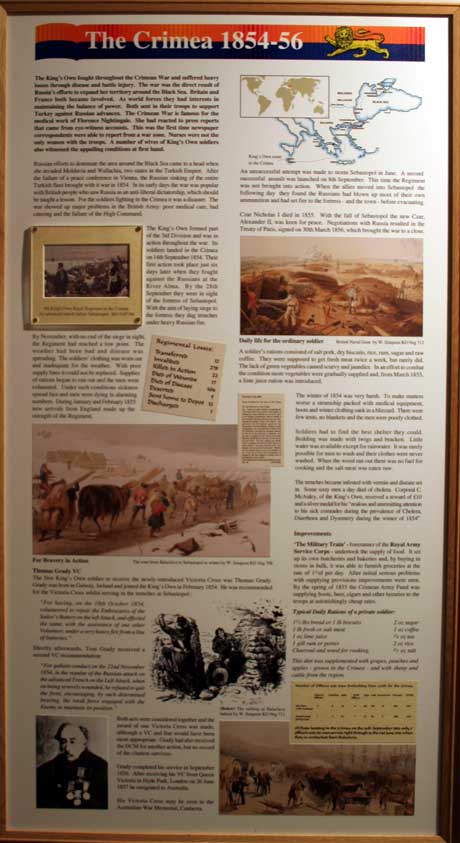
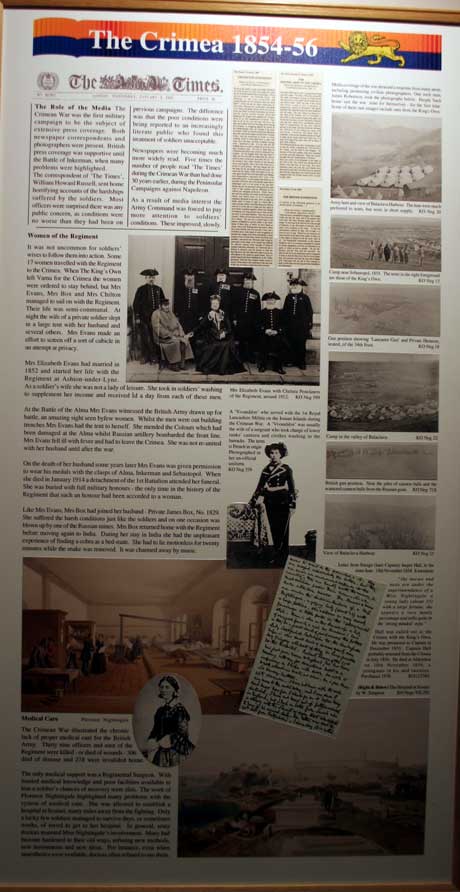
The Crimean War resulted from Russia attempting to expand her
influence around the Black Sea. Both Britain and France were concerned
by the Russian moves. Britain did not want Russia to become the dominant
power in the area. Matters came to a head when Russia invaded Moldavia
and Wallachia, two states forming part of the Turkish Empire. The
failure of a peace conference in Vienna, the French quest for glory on
foreign soil and the Russian sinking of the entire Turkish naval fleet
brought war in 1854.
The war was popular with the British people who saw Russia as
anti-liberal and an outdated reactionary, who should be taught a lesson.
However, for the soldier who was fighting in the Crimea it was a
disaster. The war showed up many problems in the British Army: poor
medical care, bad catering and the failure of the high command.
The King's Own formed part of the 3rd Division and landed in the Crimea
on 14th September 1854. Their first action took place on 20th September
when they fought with the Russians at the River Alma. By the 28th
September they were in sight of the fortress of Sebastopol.
On 1st October 1854 the construction of trenches began, under heavy
Russian fire, the majority of the works were completed by 17th October
and the siege of Sebastopol began.
By November the Regiment had reached a low point. The number of men who
were unable to perform their duties had grown. The weather had been bad
and disease was spreading. Clothing was worn out and could not be
replaced. The supply of rations began to run out and the men were
exhausted. Sickness spread and death increased alarmingly. During
January and February 1855 the Regiment was made up to strength with the
arrival of detachments from England.
An unsuccessful attempt was made to capture Sebastopol in June and a
second assault was launched on 8th September. This time the Regiment was
not brought into action. The next day the allies moved in as the
Russians had blown up the greater proportion of their own ammunition,
set fire to the town and fortress, and then evacuated it.
With the death of Czar Nicholas I in 1855 and the fall of Sebastopol,
Czar Alexander II was keen for peace. Negotiations with Russia resulted
in the Treaty of Paris, signed on 30th March 1856, which brought the war
to a close.
On 26th May 1856, The King's Own left Sebastopol and marched to the
heights of Balaclava. Finally leaving the Crimea by sea on the 21st June
1856.
Women of the Regiment
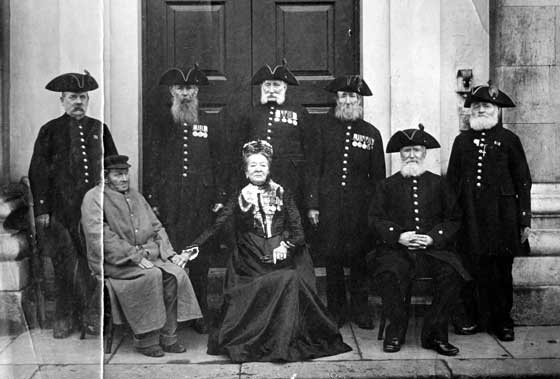
Mrs Elizabeth Evans with Chelsea Pensioners of the King's Own Royal
Regiment, including veterans of the Crimea, Indian Mutiny and Abyssinian
and Zulu Campaigns, circa 1912. She married into the Regiment in
1852 and accompanied her husband to the Crimea, one of only 17 women to
do so. Of the 17, only three, Mrs Evans, Mrs Rebecca Box and Mrs
Chilton went to the front. Mrs Evans remained with her husband
until she fell ill with fever in late 1854 and was evacuated.
After her husband's death she was given permission to wear his medals.
She died on 30th January 1914 and was buried with full military honours,
the only woman in the Regiment's history to be so honoured. Back
row: Private W Mahoney, Private W Manderville (who died on 31st May
1912), Private E Evans (no relation), Private W Gosling and
Private A A Knight. Front row: Private D Hearsum, (seated) (who
died on 2nd February 1913; Mrs Evans and Private A Smith (seated).
Accession Number: KO1783/06
Mrs Elizabeth Evans
Mrs Elizabeth Evans had married a soldier in 1852 and started her life
with the Regiment at Ashton under Lyne. As a soldiers wife she was not a
lady of leisure. She received ½d a day from each man whose washing she
did to supplement here income.
It was not uncommon for soldiers' wives to follow them into action. Mrs
Evans and sixteen other women travelled with the Regiment to the Crimea.
When The King's Own left Varna for the Crimea the women were ordered to
stay behind, but Mrs Evans, Mrs Box and Mrs Chilton managed to sail with
the Regiment. At the Battle of the Alma Mrs. Evans stood witness to the
British army drawn up for battle, an amazing sight, seen by very few
women.
Whilst the men were out building trenches Mrs Evans would have the tent
to herself. She mended the Colours which had been damaged at the Alma
whilst Russian artillery bombarded the front line. At night she and her
husband slept in a corner of the tent where she made a vain attempt to
screen off a sort of cubicle.
Mrs. Evans fell ill with fever and had to leave the Crimea. She was not
re-united with her husband until after the war.
On the death of her husband some years later Mrs. Evans was given
permission to wear his medals with the clasps of Alma, Inkerman and
Sebastopol. When she died in January 1914 a detachment of the 1st
Battalion from Dover attended the funeral. She was buried with full
military honours, the only time in the history of the Regiment that such
an honour had been accorded to a woman.
Mrs Box
Like Mrs. Evans, Mrs Box had joined her husband, Private James Box, No.
1829 - in the Crimea. She suffered the harsh conditions just like the
soldiers, and on one occasion was blown up by one of the Russian mines.
Mrs. Box returned home with the Regiment before moving again to India.
During her stay in India she had the unpleasant experience of having a
cobra as a bed-mate and was compelled to lie motionless for twenty
minutes while the snake was removed. It was charmed away by music.
Private Thomas Grady VC
Victoria Cross awarded to Private Thomas Grady, number 3319, 4th
(King’s Own) Regiment of Foot
Private Thomas Grady, born at Cheddah in Galway, Ireland, in 1835,
originally enlisted under age in the 99th Foot (2nd Battalion The
Wiltshire Regiment) at Liverpool on 8th June 1853. He transferred to the
4th King’s Own on 13th February 1854. Whilst serving in the trenches in
front of Sebastopol during the Crimean War he was recommended for the
Victoria Cross by Captain Lushington RN:
“For having, on the 18th October 1854, volunteered to repair the
Embrazures of the Sailor’s Battery on the left Attack, and effected the
same, with the assistance of one other Volunteer, under a very heavy
fire from a line of batteries.”
Shortly afterwards Tom Grady received a second VC recommendation:
“For gallant conduct on the 22nd November 1854, in the repulse of the
Russian attack on the advanced Trench on the Left Attack, when on being
severely wounded, he refused to quit the front, encouraging, by such
determined bearing, the weak force engaged with the Enemy to maintain
its position.”
The award to Grady of a VC and Bar would have been more appropriate, but
the original VC warrant did not permit the award of a Bar for a second
act of gallantry if the act occurred before the approval and
presentation of the original VC. In this case both acts of gallantry
were considered together by the War Office; the award was approved on
17th June 1857 and announced in the London Gazette of 23rd June 1857.
Grady also received the Distinguished Conduct Medal with a gratuity of
£5, but no record survives of the citation.
He completed his service on 21st September 1856 and was despatched to
pension at Aldershot on 28th October 1856. He was decorated by Queen
Victoria at the first VC presentation in Hyde Park, London on 26th June
1857 and later emigrated to Australia. He died near Melbourne on 18th
May 1891. Tom Grady’s gallantry became firmly entrenched in Regimental
folklore and tradition with the publication, around 1905, of a poem by
Ellis Williams, a former Colour Sergeant in the Regiment, entitled ‘How
Tom Grady Cleared the Gun’. His Victoria Cross was donated by his family
to the Australian War Memorial in Canberra in 1986.

Private Thomas Grady with his Victoria Cross, Distinguished Conduct
Medal and Crimean Medals.
Accession Number: KONEG0464
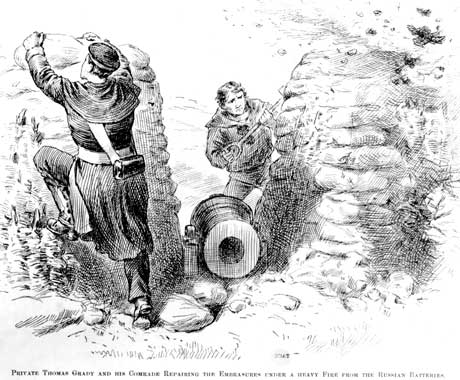
Contemporary illustration of Private Grady and his comrade repairing the
embrasures under a heavy fire from the Russian Batteries.
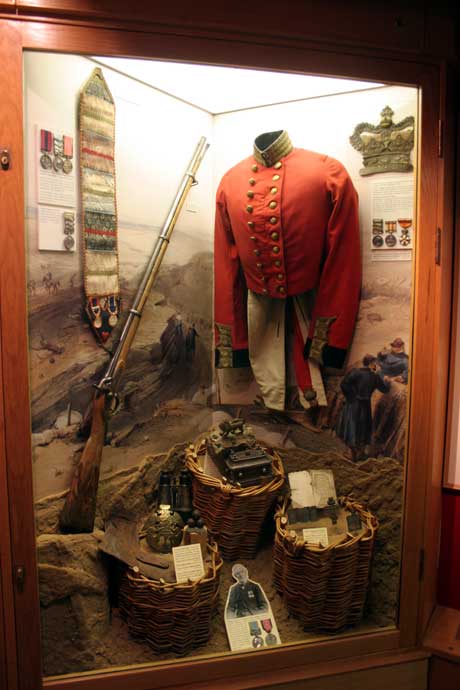
© Images are copyright, Trustees of the King's Own Royal Regiment Museum.
You must seek permission prior to
publication of any of our images.
Only a proportion of our collections
are on display at anyone time. Certain items are on loan for display
in other institutions. An appointment is required to consult any of
our collections which are held in store.







